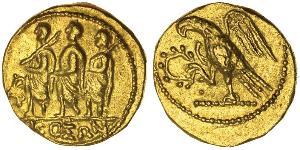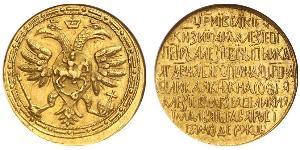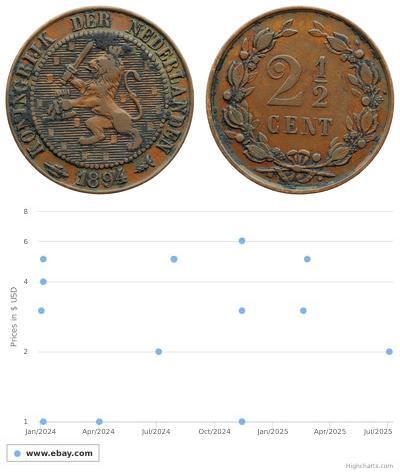[ 5428] C. Marius C. f. Capito moneyer Silver Denarius (19mm,3.65 grams) Rome mint: 81 B.C. Reference: Maria 9 var.; B.M.C. 2855-90; Syd. 744b; Craw. 378/1c CAPIT . C VIII, draped bust of Ceres right, head bound with corn-wreath, lyre before. Husbandman left, ploughing with yoke of oxen, C . MARI . C . F / S . C . in exergue. Provided with certificate of authenticity. CERTIFIED AUTHENTIC by Sergey Nechayev, PhD - Numismatic Expert In ancient Roman religion, Ceres was a goddess of agriculture, grain crops, fertility and motherly relationships. Her cult took many forms. She was the central deity in Rome's so-called plebeian or Aventine Triad, and was paired with her daughter Proserpina in what Romans described as "the Greek rites of Ceres". She played an essential role in Roman marriage and in funeral rites. Her seven-day April festival of Cerealiaincluded the popular Ludi Ceriales (Ceres' games). She was honoured in the May lustration of fields at theAmbarvalia festival, and at harvest-time. She is the only one of Rome's many agricultural deities to be listed among the Di Consentes, Rome's equivalent to the Twelve Olympians of Greek mythology. Her functions and cults were held equivalent to those of the Greek goddess Demeter, whose mythology she came to share. The Roman Republic was the phase of the ancient Roman civilisation characterised by a republican form of government. It began with the overthrow of the Roman monarchy, c. 509 BC, and lasted over 450 years until its subversion, through a series of civil wars, into the Principate form of government and the Imperial period. The Roman Republic was governed by a complex constitution, which centred on the principles of aseparation of powers and checks and balances. The evolution of the constitution was heavily influenced by the struggle between the aristocracy (the patricians), and other talented Romans who were not from famous families, the plebeians. Early in its history, the republic was controlled by an aristocracy of individuals who could trace their ancestry back to the early history of the kingdom. Over time, the laws that allowed these individuals to dominate the government were repealed, and the result was the emergence of a new aristocracy which depended on the structure of society, rather than the law, to maintain its dominance. During the first two centuries, the Republic saw its territory expand from central Italy to the entireMediterranean world. In the next century, Rome grew to dominate North Africa, the Iberian Peninsula, Greece, and what is now southern France. During the last two centuries of the Roman Republic, it grew to dominate the rest of modern France, as well as much of the east. At this point, the republican political machinery was replaced with imperialism. The precise event which signalled the end of the Roman Republic and the transition into the Roman Empireis a matter of interpretation. Towards the end of the period a selection of Roman leaders came to so dominate the political arena that they exceeded the limitations of the Republic as a matter of course. Historians have variously proposed the appointment of Julius Caesar as perpetual dictator in 44 BC, the defeat of Mark Antony at the Battle of Actium in 31 BC, and the Roman Senate's grant of extraordinary powers to Octavian (Augustus) under the first settlement in 27 BC, as candidates for the defining pivotalevent ending the Republic. Many of Rome's legal and legislative structures can still be observed throughout Europe and the rest of the world by modern nation state and international organisations. The Romans' Latin language has influenced grammar and vocabulary across parts of Europe and the world. Payment & Shipping: Will accept payments via PayPal. = MM_contentVersion;
}
else if (navigator.userAgent && navigator.userAgent.indexOf("MSIE")>=0 && (navigator.appVersion.indexOf("Win") != -1)) {
document.write('\n');
document.write('on error resume next\n');
d ...
type to read more

|
Posted by:
anonymous 2015-08-18 |
Similar Coin Groups
2025-06-16
- Historical Coin Prices
2025-06-14
- New coin is added to 1/2 Crown Ireland (1922 - )
1/2 Crown Ireland (1922 - )
group has 44 coins / 43 prices
⇑
Ireland - 1/2 Crown / 2 Shillings 6 Pence 1933 - Horse , Silver
You may be interested in ...















-300-150-cqgKbzbiQeMAAAFLYpCjltiK.jpg)






